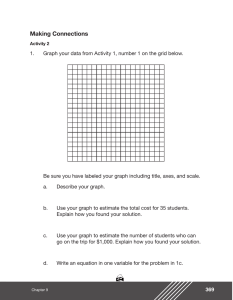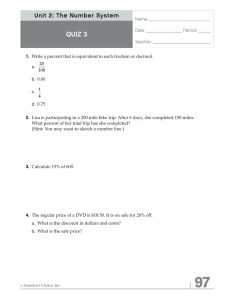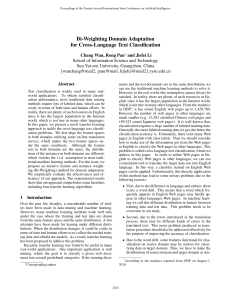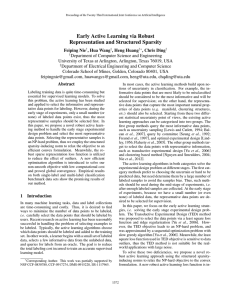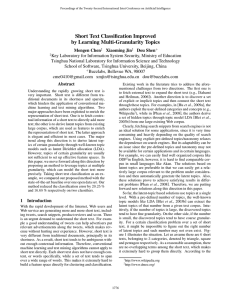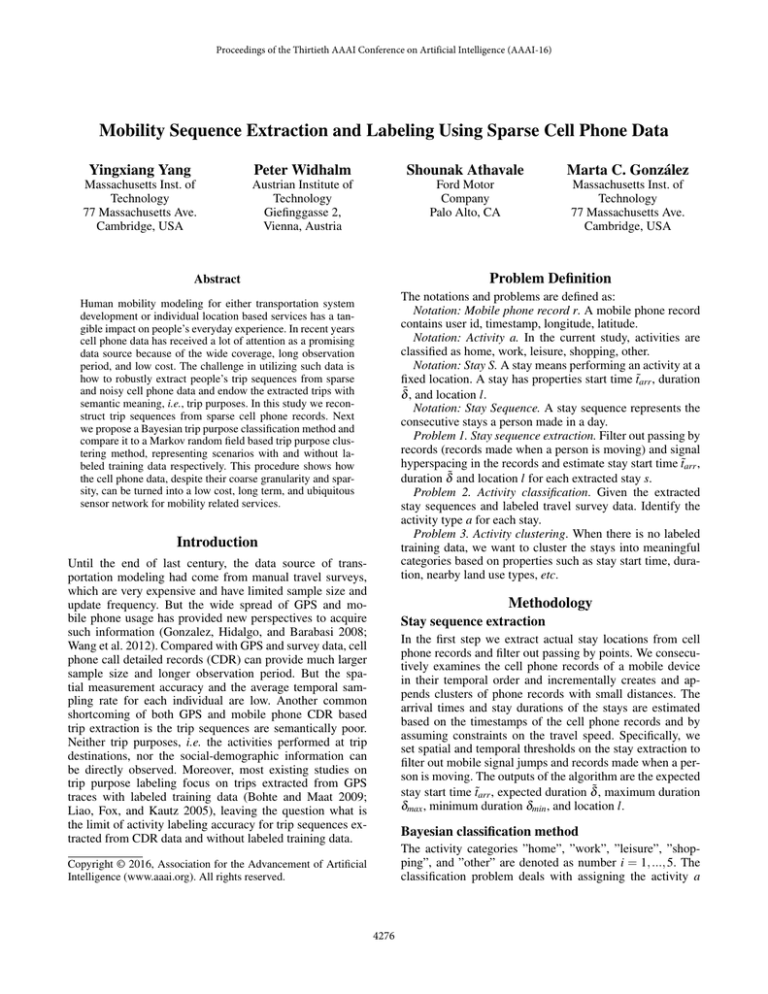
Proceedings of the Thirtieth AAAI Conference on Artificial Intelligence (AAAI-16)
Mobility Sequence Extraction and Labeling Using Sparse Cell Phone Data
Yingxiang Yang
Peter Widhalm
Shounak Athavale
Marta C. González
Massachusetts Inst. of
Technology
77 Massachusetts Ave.
Cambridge, USA
Austrian Institute of
Technology
Giefinggasse 2,
Vienna, Austria
Ford Motor
Company
Palo Alto, CA
Massachusetts Inst. of
Technology
77 Massachusetts Ave.
Cambridge, USA
Problem Definition
Abstract
The notations and problems are defined as:
Notation: Mobile phone record r. A mobile phone record
contains user id, timestamp, longitude, latitude.
Notation: Activity a. In the current study, activities are
classified as home, work, leisure, shopping, other.
Notation: Stay S. A stay means performing an activity at a
fixed location. A stay has properties start time t˜arr , duration
δ̃ , and location l.
Notation: Stay Sequence. A stay sequence represents the
consecutive stays a person made in a day.
Problem 1. Stay sequence extraction. Filter out passing by
records (records made when a person is moving) and signal
hyperspacing in the records and estimate stay start time t˜arr ,
duration δ̃ and location l for each extracted stay s.
Problem 2. Activity classification. Given the extracted
stay sequences and labeled travel survey data. Identify the
activity type a for each stay.
Problem 3. Activity clustering. When there is no labeled
training data, we want to cluster the stays into meaningful
categories based on properties such as stay start time, duration, nearby land use types, etc.
Human mobility modeling for either transportation system
development or individual location based services has a tangible impact on people’s everyday experience. In recent years
cell phone data has received a lot of attention as a promising
data source because of the wide coverage, long observation
period, and low cost. The challenge in utilizing such data is
how to robustly extract people’s trip sequences from sparse
and noisy cell phone data and endow the extracted trips with
semantic meaning, i.e., trip purposes. In this study we reconstruct trip sequences from sparse cell phone records. Next
we propose a Bayesian trip purpose classification method and
compare it to a Markov random field based trip purpose clustering method, representing scenarios with and without labeled training data respectively. This procedure shows how
the cell phone data, despite their coarse granularity and sparsity, can be turned into a low cost, long term, and ubiquitous
sensor network for mobility related services.
Introduction
Until the end of last century, the data source of transportation modeling had come from manual travel surveys,
which are very expensive and have limited sample size and
update frequency. But the wide spread of GPS and mobile phone usage has provided new perspectives to acquire
such information (Gonzalez, Hidalgo, and Barabasi 2008;
Wang et al. 2012). Compared with GPS and survey data, cell
phone call detailed records (CDR) can provide much larger
sample size and longer observation period. But the spatial measurement accuracy and the average temporal sampling rate for each individual are low. Another common
shortcoming of both GPS and mobile phone CDR based
trip extraction is the trip sequences are semantically poor.
Neither trip purposes, i.e. the activities performed at trip
destinations, nor the social-demographic information can
be directly observed. Moreover, most existing studies on
trip purpose labeling focus on trips extracted from GPS
traces with labeled training data (Bohte and Maat 2009;
Liao, Fox, and Kautz 2005), leaving the question what is
the limit of activity labeling accuracy for trip sequences extracted from CDR data and without labeled training data.
Methodology
Stay sequence extraction
In the first step we extract actual stay locations from cell
phone records and filter out passing by points. We consecutively examines the cell phone records of a mobile device
in their temporal order and incrementally creates and appends clusters of phone records with small distances. The
arrival times and stay durations of the stays are estimated
based on the timestamps of the cell phone records and by
assuming constraints on the travel speed. Specifically, we
set spatial and temporal thresholds on the stay extraction to
filter out mobile signal jumps and records made when a person is moving. The outputs of the algorithm are the expected
stay start time t˜arr , expected duration δ̃ , maximum duration
δmax , minimum duration δmin , and location l.
Bayesian classification method
The activity categories ”home”, ”work”, ”leisure”, ”shopping”, and ”other” are denoted as number i = 1, ..., 5. The
classification problem deals with assigning the activity a
Copyright © 2016, Association for the Advancement of Artificial
Intelligence (www.aaai.org). All rights reserved.
4276
of a stay S to one of the numbers in i = 1, ..., 5. We utilize the start time t˜arr , duration δ̃ , location l of each stay
and transition probability P(i1 , i2 ) between activities i1 and
i2 (i1 , i2 = 1, ..., 5) from the labeled training data to construct the classifier. Among the 5 activity types, ”home” and
”work” have more distinct start time, duration and location
distributions, while the other three activities are harder to
distinguish based on these three features. Based on this characteristic of extracted trips, we perform a stepwise classification. The first step classifies the activities into ”home”,
”work”, and ”the rest” based on activity start time, duration and location. Then in the second step we further distinguish ”leisure”, ”shopping”, and ”other” while considering
the transition probability between activities. For example,
in an activity sequence H − a1 − a2 −W − a3 − H, the first,
fourth, and sixth activities have been identified to be home
or work after step one. These activities divide the entire activity sequence into blocks of unknown labels and then we
can decide the activity labels in each block simultaneously.
entire table sums up to 100%. Overall speaking, 66.2% of
stays in the five clusters could be matched to their corresponding survey classes.While in travel surveys, sometimes
activities are divided into three classes, ”home”, ”work”, and
”other”. If we use this simpler classification scheme, 93.9%
activities could be matched to their corresponding clusters.
While if labeled training data is available, in the Bayesian
Table 1: Confusion matrix between stay clusters C and survey activity classes
C1
C2
C3
C4
C5
Home
35.4% 0.3%
0.1% 0.0% 0.1%
Work
0.2%
14.3% 0.8% 0.3% 1.2%
Leisure
0.7%
0.8%
2.5% 3.1% 6.0%
Shopping 0.1%
0.0%
1.8% 2.4% 5.2%
Other
0.7%
0.4%
7.9% 3.6% 11.8%
classification method. 79.4% of all the activities could be
correctly classified, as in shown in Table 2. More importantly, the classification accuracy of the confounding classes,
”leisure”, ”shopping”, ”other” increases dramatically to over
50%. They are 52.3%, 54.1% and 68.1% respectively.
Markov random field clustering method
When there is no labeled training data for classification, we
can still reveal the spatial-temporal structure of activities by
performing clustering. For this we adopt a technique we first
introduced in (Widhalm et al. 2015) which combines different properties of an activity such as activity start time, duration, location, and the number of visits to that location using
an undirected graphic model, Markov random field. The inputs are: vectors P = (p1 , ..., pn ) of land use shares in proximity of the estimated locations; arrival times t = (t1 , ...,tn );
stay durations δ = (δ1 , ..., δn ), and the sequence of stay location indexes i = (i1 , ..., in ) which number consecutively
the distinct locations visited during a day. We define interrelations between the variables (P, t,δδ , i) describing an activity sequence as six cliques C1 , ...,C6 with potential functions φ1 , ..., φ6 representing the relationships between:
• C1 : prior probability of activity type A itself;
Table 2: Confusion matrix between classified and real activity classes
C1
C2
C3
C4
C5
Home
35.7% 0.1%
0.1% 0.0% 0.1%
Work
0.1%
15.1% 1.1% 0.2% 0.4%
Leisure
0.6%
1.2%
6.8% 1.9% 2.5%
Shopping 0.1%
0.1%
1.3% 5.2% 2.8%
Other
0.6%
0.8%
2.9% 3.4% 16.6%
References
Bohte, W., and Maat, K. 2009. Deriving and validating trip purposes and travel modes for multi-day gps-based
travel surveys: A large-scale application in the netherlands.
Transportation Research Part C: Emerging Technologies
17(3):285–297.
Gonzalez, M. C.; Hidalgo, C. A.; and Barabasi, A.-L. 2008.
Understanding individual human mobility patterns. Nature
453:779–782.
Liao, L.; Fox, D.; and Kautz, H. 2005. Location-based activity recognition using relational markov networks. In Proceedings of the 19th International Joint Conference on Artificial Intelligence, IJCAI’05, 773–778. San Francisco, CA,
USA: Morgan Kaufmann Publishers Inc.
Wang, P.; Hunter, T.; Bayen, A. M.; Schechtner, K.; and
González, M. C. 2012. Understanding road usage patterns
in urban areas. Scientific reports 2.
Widhalm, P.; Yang, Y.; Ulm, M.; Athavale, S.; and González,
M. C. 2015. Discovering urban activity patterns in cell
phone data. Transportation 42(4):597–623.
• C2 : activity type A and land use type L ;
• C3 : activity type A, starting time T and duration D of the
activity;
• C4 : the activity type A and a binary indicator R that the
activity location is visited more than once during the day;
• C5 : the activity type A and a binary indicator Up that the
activity is performed at only one unique location;
• C6 : an indicator Ua that only one unique activity is performed at location i j .
Given the unsupervised nature of the problem, we use an
EM (expectation-maximization) based learning scheme, to
fit the potential functions to the data.
Preliminary Results
To quantitatively show how the clusters from the MRF
method can be matched to the five survey defined classes,
we use a travel survey data as input to the trained MRF cluster model and observe the confusion matrix in Table 1. The
4277

